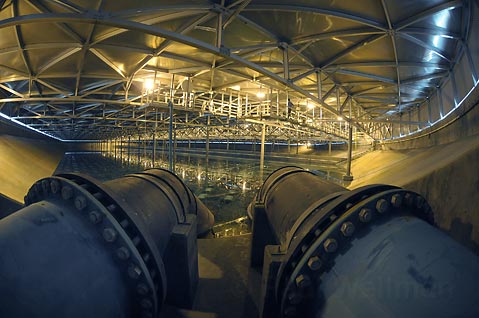Ortega Reservoir Deemed Safe by Feds
Leak Litigation

A leak at the Ortega Reservoir continues to be as much of a problem today as it did when it was discovered a year ago.
Originally built in the 1950s as part of the Cachuma water system, the Ortega Reservoir in 2007 received a four-acre, $18.5-million aluminum cover in order to keep the concrete-lined reservoir in compliance with federal drinking water standards. Then the reservoir sprang a leak, with water flowing from it as quickly as 70 gallons per minute. Because Ortega Reservoir is owned by the U.S. Bureau of Reclamation and managed by the Montecito and Carpinteria water districts along with the Cachuma Operations and Maintenance Board, the lines have become blurred as to who takes responsibility for the leak. What is clear is that customers in the Montecito and Carpinteria Valley districts have been left holding the bag for repairs that Tom Mosby, Montecito District general manager, said could reach seven figures. “This is a big expense for us-something I wish we didn’t have to do,” he said, adding that a normal rate of leakage for a holding reservoir is 5to10 gallons per minute. The leak was discovered last spring, when monitoring equipment detected that the amount of water leaking out had increased dramatically.

Mosby said the cover was necessary to reduce the amount of potentially carcinogenic byproducts produced when chlorine mixes with organic materials. An improved circulation system was also required to ensure that treated water didn’t get stale at one end of the 21-million-gallon holding pond. Installation of the roof’s support beams and circulation system meant that several of the concrete panels at the bottom of the reservoir had to be replaced, which Mosby and Carp District general manager Charles Hamilton suspect caused the leak. “We believe that they weren’t properly installed,” said Mosby of the panels, adding that the sealant in the joints between the concrete slabs became a cause for concern after recent testing was conducted. “Before the [cover was installed], it was leaking about three to five gallons per minute.”
The two districts are splitting the costs of inspecting and repairing the leak as well as the legal fees accompanying litigation against Penfield & Smith-the Santa Barbara-based engineering firm which, along with Cushman Construction, installed the cover. “Penfield and Smith was willing to help, but only if they were paid for services. We thought that the work should be guaranteed,” Mosby said. Early efforts to find the leak involved dye testing and scuba divers, and failed to identify the problem. The reservoir then had to be emptied this past March and April to perform further tests. A 12-foot-by-five-foot section of concrete was cut into two pieces and removed. This operation alone cost $30,000.
The operating capacity of the reservoir has been diminished by a third, slowing the leak to about 40 gallons per minute, but managers said even then enough water exists in the entire supply system-Cachuma, State Water, Carpinteria’s Foothill reservoir, and the 3-million-gallon storage tank at Rancho Monte Allegre in Carpinteria-to ensure adequate supply throughout the high-demand summer months.
Concern has also been raised about other issues, such as available water supply during wildfires and ground saturation affecting the stability of the hillside, but regular monitoring by the districts and the bureau have indicated neither is cause for concern at this point. A spokesperson for the bureau said that the agency has placed no restrictions on the operating level of the reservoir. “The City of Santa Barbara Cater treatment facility was able to send 12 million gallons per day to Montecito and Carpinteria water districts [during the Jesusita Fire]. This in conjunction with our other supplies, the Foothill Reservoir, and customers actually cutting back on usage during the fire [mean that] our other water storage levels held and systems performed well,” said Mosby.
Counsel for the two districts indicated that they are still awaiting a trial date before Judge James Brown in the Santa Barbara Superior Court.



